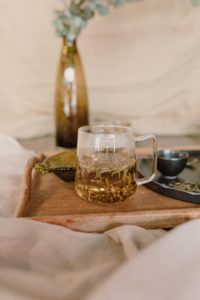
I overheard someone at a tea shop speaking about Silver Needle white tea, and while I had heard of this delicate tea and seen it many times, I had not taken the time to understand its many benefits. Quickly piping up, I asked the person (who was buying 200 grams of the tea) what makes the tea special? They were quick to rave on the topic, explaining that they had been drinking this tea every day for the last 15 years and that their skin has never felt healthier. They didn’t necessarily understand the science behind it — all they knew was that it WORKED.
Having an inquisitive and quantitative mind, I was soon drinking a cup and diving into the tea research. I was eager to understand this phenomenon’s root after experiencing skin issues in the past (acne and sensitivity). Within two weeks, I began seeing a benefit in my skin. I was halfway through an Integrative Health Practitioner certification at the time, and the science behind this tea and its effect on skin health stuck with me. All that I have read points to one fact: healthy skin begins in your gut microbiome!

Silver Needle white tea is one of the most exquisite, rare, and simple teas. As it is known in China, Bai Hao Yin Zhen (white hair silver needle) is made from downy, tender, uppermost tea buds picked by hand before they open at sunrise. The mother Da Bai (large white) cultivar resides in the Hongxue Cave on Taimu Mountain in Fujian Province. Because of their delicacy, the narrow leaf shoots are harvested for only a few days in late March and April. The timing and precise pluck retain the white down (a silver trichome). This tea is brewed below boiling to bring out the full flavor. Several green teas display prominent trichomes but have different biochemical potency and taste than the genuine white tea Silver Needle. Because of its uniqueness, rareness, and super smooth texture, Silver Needle is considered one of the most expensive and top-quality teas in the world. It was first exported in 1891 and remains popular worldwide.
The science behind this simple tea is relatively complex.
The tea’s plush silver needles are rich in high molecular weight polyphenols. Drinking Silver Needle can help gut microbiota adjust biological activities, improve nutrient bioavailability, and produce antioxidants such as flavonols and phenolic metabolites (Cardona et al., 2013). Flavonoids help the body maintain cellular health and balance the immune system while supporting the body’s natural anti-inflammatory pathways. Moreover, phenolic metabolites may also promote health and can minimize the chances of contracting some chronic diseases.
Nearly 37% of the total catechin content is in the leaf, which makes catechins intestinally bioaccessible and bioavailable. Catechins are a type of flavonoid (plant chemical) that protects plants from environmental toxins, and gives them a strong antioxidant content. Catechins are accumulated in the intestinal lumen where cholesterol uptake and inhibition of cellular glucose occurs. These catechins bind to plasma HDLs, which, in turn, regulate the cholesterol and plasma glucose levels (Tenore, 2015). Along with these benefits, catechins can also act as a prebiotic that supports gut health.
The connection between the gut microbiome and skin health is referred to as the Gut-Brain-Skin axis. This concept was conceived by dermatologists John H. Stokes and Donald M. Pillsbury and explains the connection between our gut health and skin health.
Here’s how drinking tea impacts skin health directly

Silver Needle white tea lessens the activity of some of the enzymes that help break down elastin and collagen in the skin. This leads to anti-aging effects such as wrinkles becoming less visible, and the skin looking younger and glowing (Thring, Hili, & Naughton, 2009). Flavanol is present in Silver Needle, which helps to remove excess oil and sebum from clogged pores. Open pores help prevent acne breakouts and allow the skin to remain healthy.
Sun exposure depletes the skin’s natural immune response and can be restored by drinking Silver Needle, which also protects skin cells from sun damage. Since blood vessels are not in the first layer of the skin, known as the epidermis, skin nourishment is absorbed in the second layer (dermis) where blood vessels are in abundance. Certain qualities of vitamins and nutrients (i.e., the fact that they are easily oxidized and their molecular weight) prevent them from reaching the lowermost layer of skin. It is better to ingest vitamins and nutrients rather than apply them topically.
This is why cosmetic and dermatological companies offer ingestible skincare products. The use of botanicals, including tea, is a trend embraced by the skincare industry as consumer preference shifts towards a holistic approach that accepts the fact that many different body mechanisms are connected.
Silver Needle white tea plays a significant role in developing healthy and glowing skin, leading to greater use of tea extracts in these ingestible skincare products.
References
Begley, M., Hill, C., & Gahan, C. G. (2006). Bile salt hydrolase activity in probiotics. Applied and environmental microbiology, 72(3), 1729-1738.
Bowe, W. Logan, A. (2011) Acne vulgaris, probiotics, and the gut-brain-skin axis – back to the future? Gut Pathogens, BioMed Central
Cardona, F., Andrés-Lacueva, C., Tulipani, S., Tinahones, F. J., & Queipo-Ortuño, M. I. (2013). Benefits of polyphenols on gut microbiota and implications in human health. The Journal of nutritional biochemistry, 24(8), 1415-1422.
Huang, F., Zheng, X., Ma, X., Jiang, R., Zhou, W., Zhou, S., Zhang, Y., Lei, S., Wang, S., Kuang, J., Han, X. (2019). Theabrownin from Pu-erh tea attenuates
hypercholesterolemia via modulation of gut microbiota and bile acid metabolism. Nature communications, 10(1), 1-17.
Jie, G., Lin, Z., Zhang, L., Lv, H., He, P., & Zhao, B. (2006). Free radical scavenging effect of Pu-erh tea extracts and their protective effect on oxidative damage in human fibroblast cells. Journal of agricultural and food chemistry, 54(21), 8058-8064.
Tenore, G. C., Campiglia, P., Giannetti, D., & Novellino, E. (2015). Simulated gastrointestinal digestion, intestinal permeation, and plasma protein interaction of white, green, and black tea polyphenols. Food Chemistry, 169, 320-326.
Thring, T. S., Hili, P., & Naughton, D. P. (2009). Anti-collagenase, anti-elastase, and antioxidant activities of extracts from 21 plants. BMC complementary and alternative medicine, 9(1), 27.
Tea Market
Get More Value from Your Tea: BRU Maker One
+41794574278
Jacque's Organics
(647) 804-7263